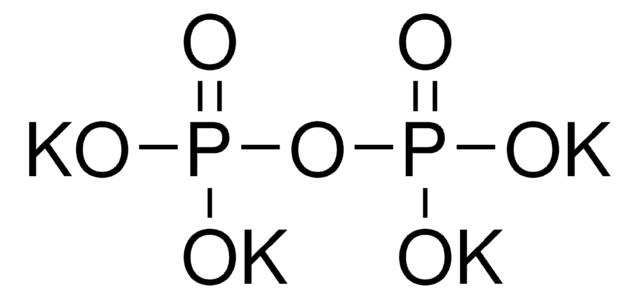A6338
Aldehyde Dehydrogenase, potassium-activated from baker′s yeast (S. cerevisiae)
lyophilized powder, ≥2.0 units/mg protein
Sinonimo/i:
Aldehyde:NAD[P]+ oxidoreductase
Autenticatiper visualizzare i prezzi riservati alla tua organizzazione & contrattuali
About This Item
Forma fisica
lyophilized powder
Attività specifica
≥2.0 units/mg protein
PM
228 kDa
Composizione
Protein, ≥5.0% biuret
Condizioni di spedizione
dry ice
Temperatura di conservazione
−20°C
Descrizione generale
Aldehyde dehydrogenase is a tetramer and has several different isoforms. The enzyme tested in 0.01 M pyrophosphate buffer shows a sharp optimum around pH 9.3 with acetaldehyde as substrate. Potassium ions and cysteine are essential for the enzyme′s activity. Rubidium or NH4+ can be substituted for K+, and glutathione for cysteine. Lithium, Na+, and Cs+ inhibit the reaction. Aldehyde dehydrogenase is inhibited by propylurea, crotonaldehyde, n-propyl isocyanate, cyclohexyl isocyanate, 1-n-propyl-1-[(4-chlorophenyl)sulphonyl]-3-n-propylurea, and 1-methyl-1-[(4-chlorophenyl)sulphonyl]-3-n-propylurea. The enzyme may be utilized to quantitate aldehydes present in blood.
Aldehyde dehydrogenase (ALDH) is present in the nucleus, cytosol, mitochondria and endoplasmic reticulum of cells.
Applicazioni
Aldehyde dehydrogenase (ALDH) has been used to evaluate the effects of pear extracts on ALDH activity. It has also been used to colorimetrically determine ethanol by monitoring the enzymatic reduction of nicotinamide adenine dinucleotide (NAD).
Azioni biochim/fisiol
Aldehyde dehydrogenase from baker′s yeast catalyzes the reduction of pyridine nucleotides by several aldehydes. It catalyzes the oxidation of a wide range of substrates, such as acetaldehyde, formaldehyde, propionaldehyde, n-butylaldehyde, isobutylaldehyde, n-valeraldehyde, caproaldehyde, benzaldehyde, glycoaldehyde, D-glyceraldehyde, malonic semialdehyde, and succinic aldehyde. Aldehyde dehydrogenase is used to study the production of ethanol and isobutanol. Ethanol concentration can be determined colorimentrically by monitoring the enzymatic reduction of nicotinamide adenine dinucleotide (NAD) using alcohol dehydrogenase after preremoval of aldehyde by aldehyde dehydrogenase.
Definizione di unità
One unit will oxidize 1.0 μmole of acetaldehyde to acetic acid per min at 25 °C at pH 8.0 in the presence of β-NAD+, potassium and thiols.
Stato fisico
Contains lactose, potassium phosphate and citrate buffer salts, and mercaptosuccinic acid.
Ricostituzione
This enzyme can be dissolved at 0.3 mg/mL in 100 mM Tris-HCl buffer (pH 8.0), containing 0.02% BSA.
Codice della classe di stoccaggio
11 - Combustible Solids
Classe di pericolosità dell'acqua (WGK)
WGK 3
Punto d’infiammabilità (°F)
Not applicable
Punto d’infiammabilità (°C)
Not applicable
Dispositivi di protezione individuale
Eyeshields, Gloves, type N95 (US)
Certificati d'analisi (COA)
Cerca il Certificati d'analisi (COA) digitando il numero di lotto/batch corrispondente. I numeri di lotto o di batch sono stampati sull'etichetta dei prodotti dopo la parola ‘Lotto’ o ‘Batch’.
Possiedi già questo prodotto?
I documenti relativi ai prodotti acquistati recentemente sono disponibili nell’Archivio dei documenti.
I clienti hanno visto anche
Enzymic determination of acetaldehyde in blood.
F LUNDQUIST
The Biochemical journal, 68(1), 172-177 (1958-01-01)
Monoamine oxidase A activity in fibroblasts as a functional confirmation of MAOA variants.
Tessa M A Peters et al.
JIMD reports, 58(1), 114-121 (2021-03-18)
A two-stage, two-organism process for biohydrogen from glucose
Redwood MD and Macaskie LE
International Journal of Hydrogen Energy, 31(11), 1514-1521 (2006)
Sergey Stolyar et al.
Molecular systems biology, 3, 92-92 (2007-03-14)
The rate of production of methane in many environments depends upon mutualistic interactions between sulfate-reducing bacteria and methanogens. To enhance our understanding of these relationships, we took advantage of the fully sequenced genomes of Desulfovibrio vulgaris and Methanococcus maripaludis to
Effects and action mechanisms of Korean pear (Pyrus pyrifolia cv. Shingo) on alcohol detoxification.
Ho-Sun Lee et al.
Phytotherapy research : PTR, 26(11), 1753-1758 (2012-03-28)
Korean pear (Pyrus pyrifolia cv. Shingo) has been used as a traditional medicine for alleviating alcohol hangover. However, scientific evidence for its effectiveness or mechanism is not clearly established. To investigate its mechanism of alcohol detoxification, both in vitro and
Il team dei nostri ricercatori vanta grande esperienza in tutte le aree della ricerca quali Life Science, scienza dei materiali, sintesi chimica, cromatografia, discipline analitiche, ecc..
Contatta l'Assistenza Tecnica.
